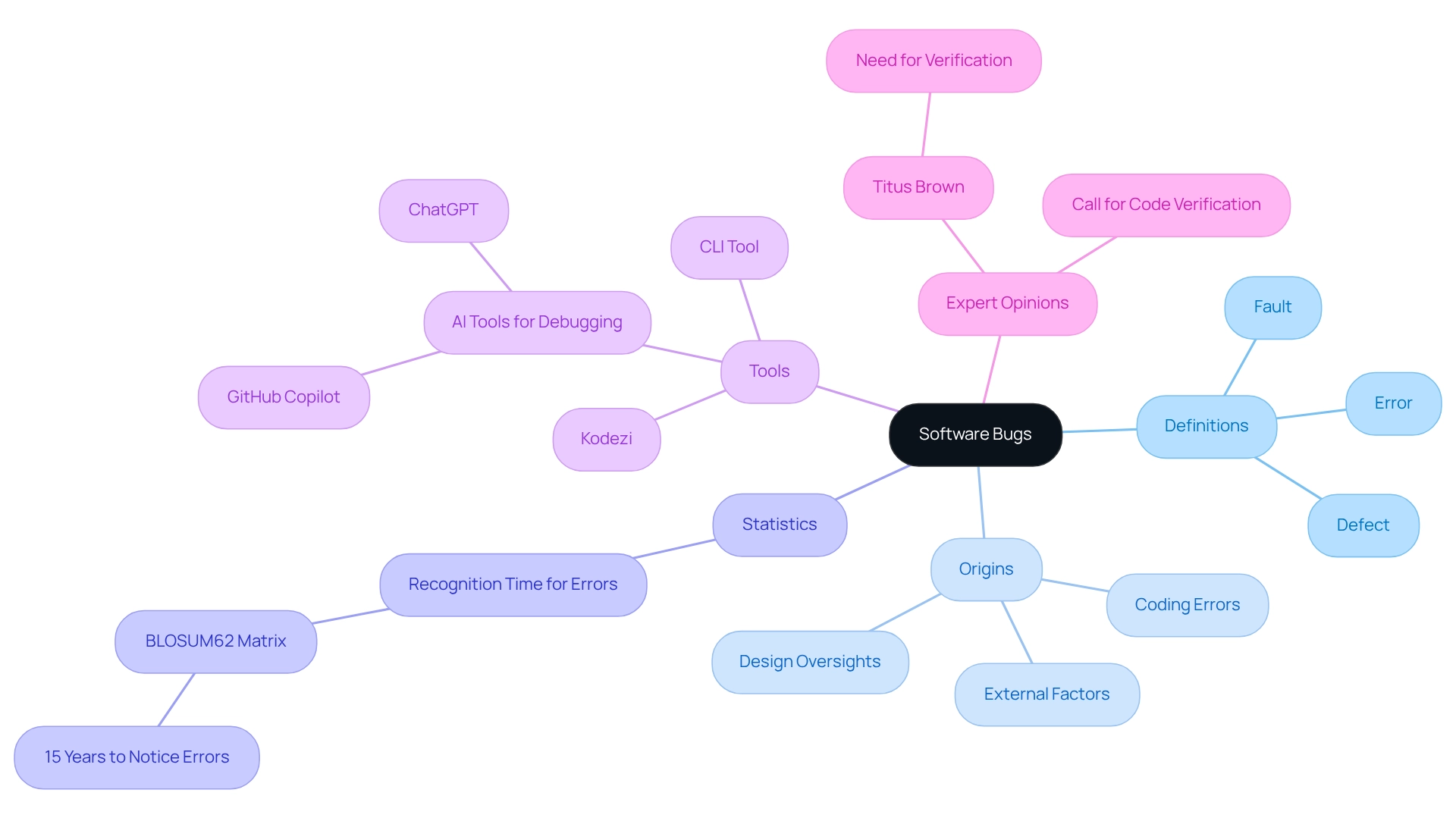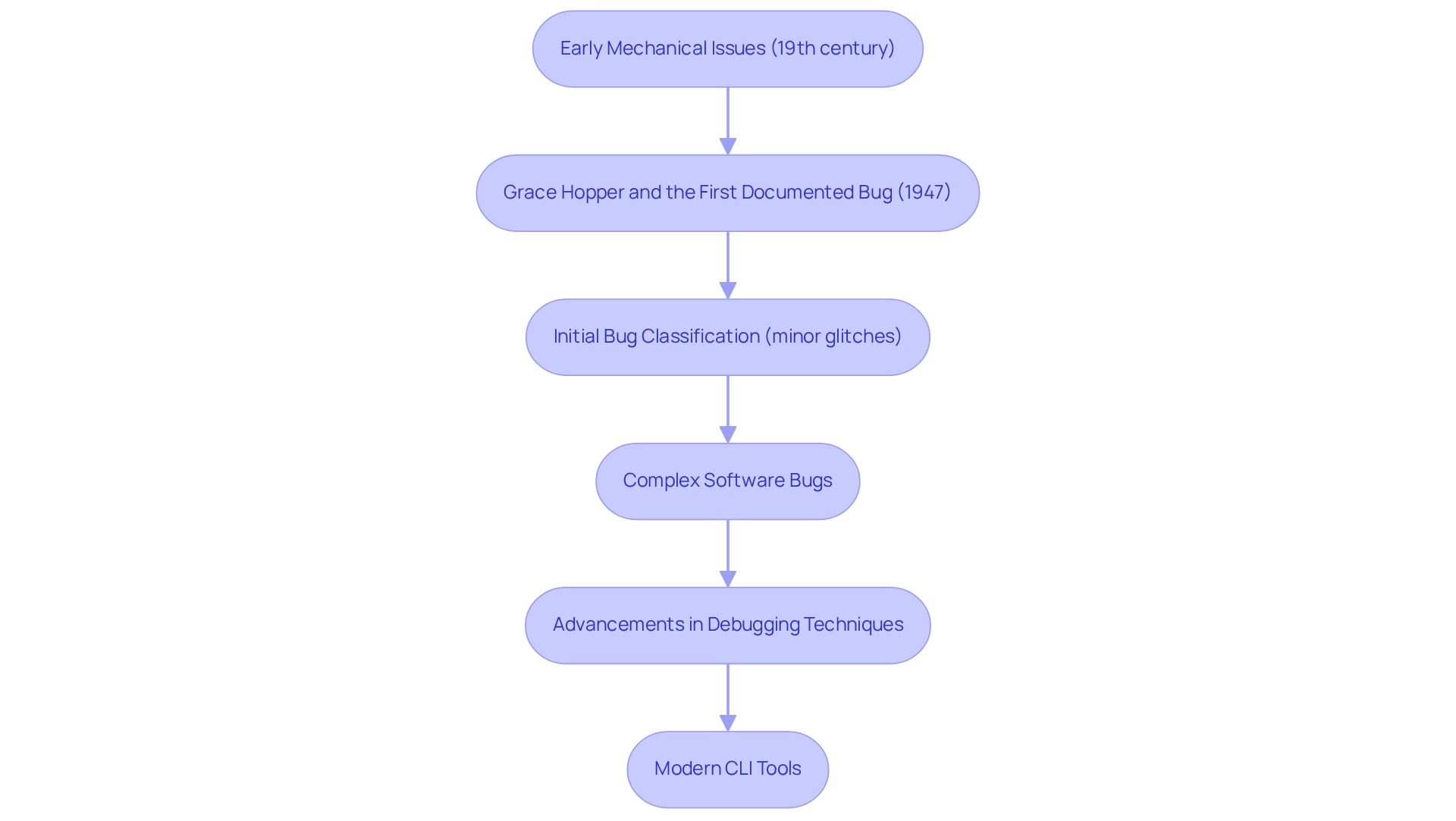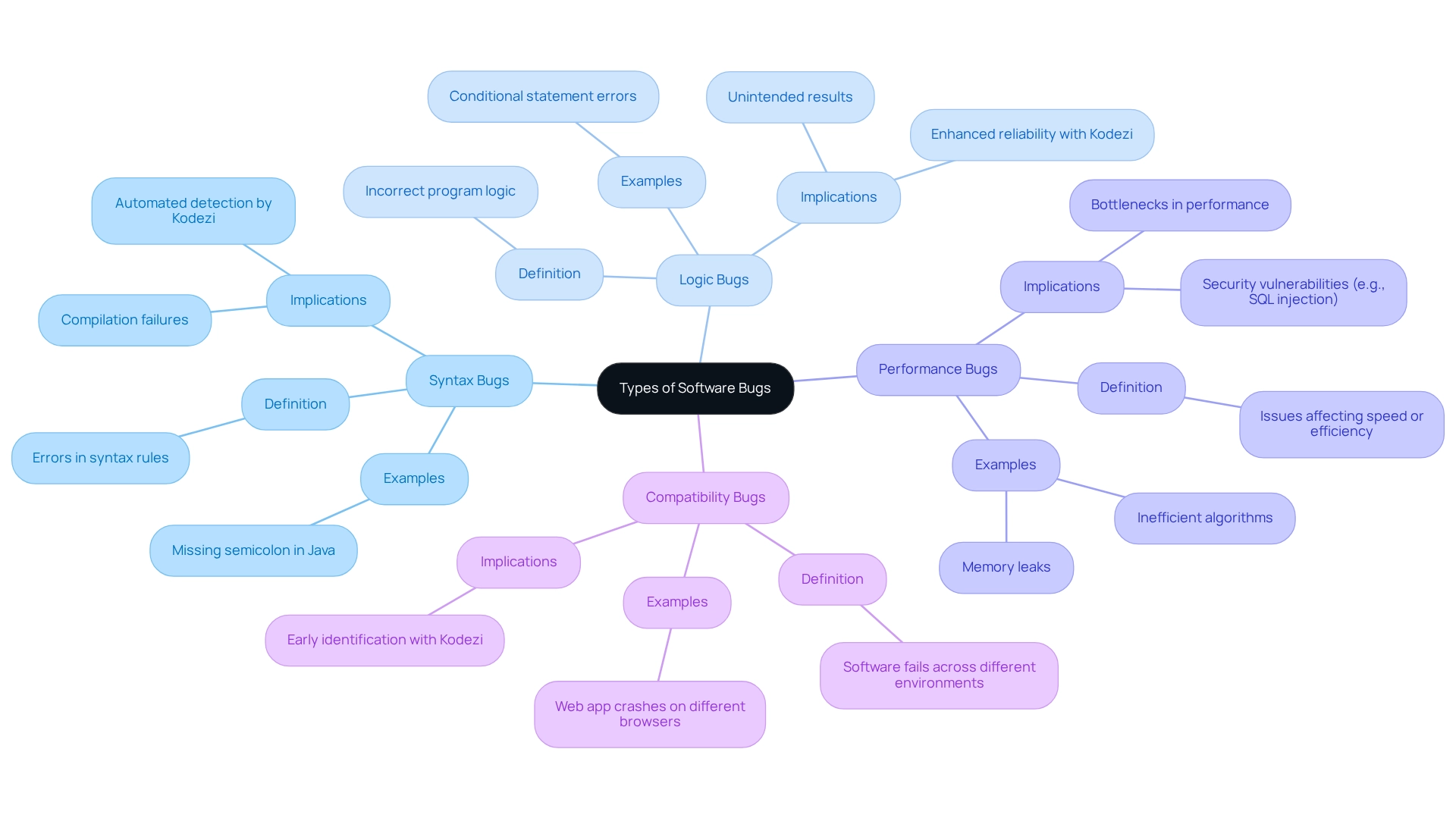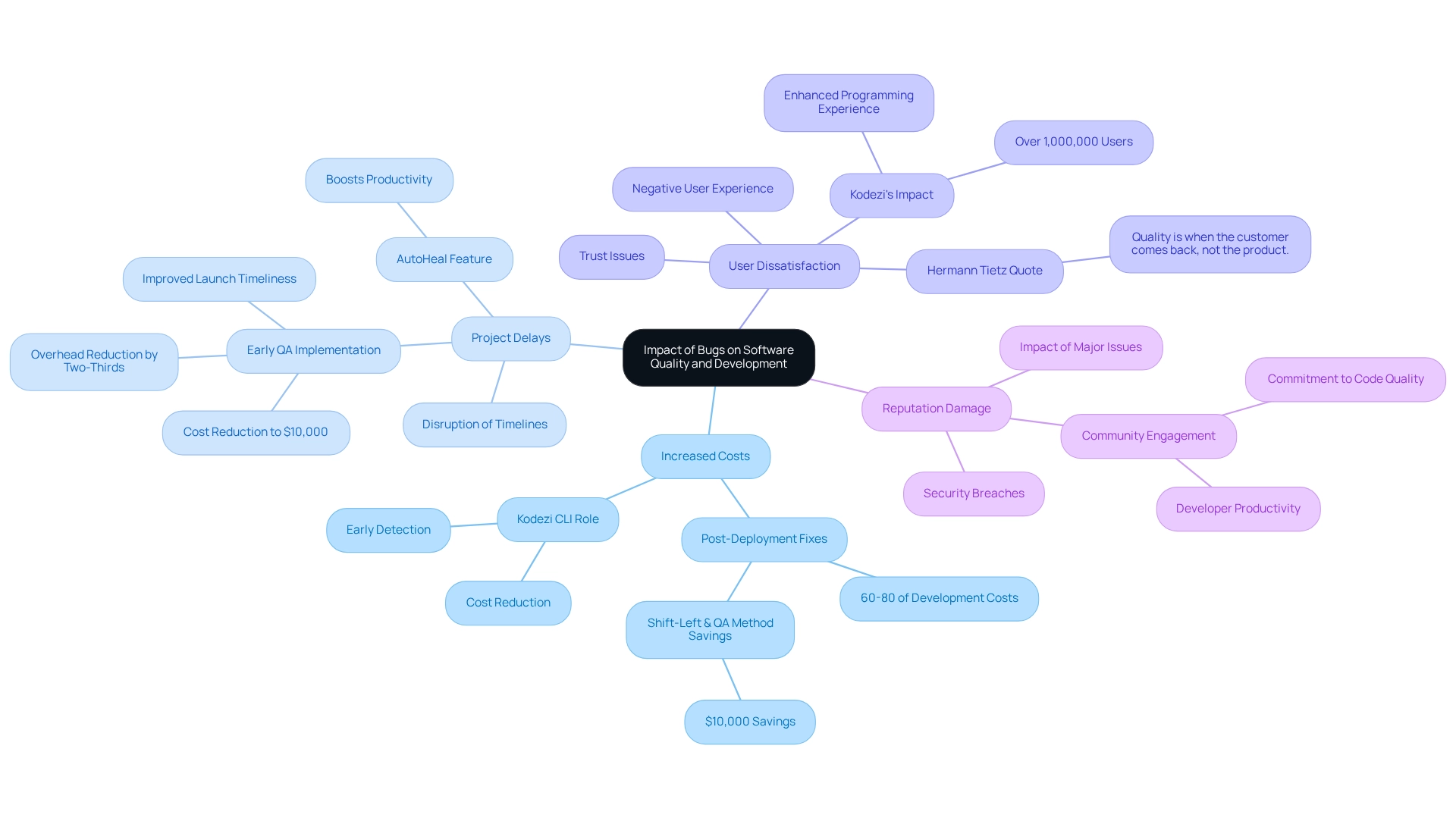Overview
In the realm of software development, coding challenges are an ever-present hurdle that developers must navigate. A bug, defined as a flaw or error within an application, can lead to incorrect or unexpected outcomes, often stemming from coding mistakes, design oversights, or external influences. Understanding the various types of bugs and their impacts on software quality is crucial. This is where Kodezi comes into play, offering effective debugging practices and tools that are essential for maintaining high-quality code.
Kodezi addresses these challenges head-on with features designed to streamline the debugging process. For instance, its intuitive interface allows developers to quickly identify and rectify issues, minimizing the time spent on troubleshooting. Furthermore, Kodezi's advanced algorithms enhance the debugging experience, ensuring that developers can focus on what truly matters—writing efficient code.
The benefits of using Kodezi extend beyond just fixing bugs; it significantly improves productivity and code quality. By integrating Kodezi into your workflow, you can reduce costs associated with post-deployment fixes and enhance overall software performance. In addition, the platform's tools empower developers to adopt best practices, fostering a culture of quality and efficiency.
Are you ready to elevate your coding practices? Explore the tools available on Kodezi’s platform today and transform the way you approach software development. With Kodezi, you can tackle coding challenges effectively and ensure your projects meet the highest standards of quality.
Introduction
In the intricate world of software development, coding challenges, particularly the presence of bugs, pose a significant threat to functionality and user trust. Developers often grapple with issues ranging from minor glitches to critical vulnerabilities. Understanding the various types of software bugs is essential for those striving to enhance code quality and ensure smooth operations. Furthermore, as the complexity of systems increases, so does the need for effective debugging strategies.
In addition, emerging technologies, such as AI-driven tools like Kodezi, are revolutionizing the way developers tackle bug management. Kodezi offers automated solutions that streamline the debugging process, making it easier for developers to focus on what truly matters—building robust software. Imagine a scenario where bugs are identified and resolved swiftly, allowing for a more efficient development cycle.
The benefits of using Kodezi are clear: improved productivity and enhanced code quality lead to greater user satisfaction. By integrating Kodezi into their workflow, developers can significantly reduce the time spent on debugging, allowing for more innovation and creativity in their projects.
Explore the tools available on the Kodezi platform to transform your approach to software development. How could your coding practices improve with the right debugging solutions? This exploration delves into the definition, historical context, classifications, and impacts of software bugs, illuminating the vital role they play in shaping the quality and reliability of software products.
Defining a Software Bug: Core Concepts and Terminology
The meaning of bug in computer refers to a flaw or error within a computer application that leads to incorrect or unexpected outcomes. These issues can manifest in various ways, such as application crashes, erroneous outputs, or unintended behaviors. Issues can arise from various origins, such as coding errors, design oversights, or external factors that affect application performance.
Comprehending the language related to issues is essential for efficient recognition and classification. Common terms include 'defect', 'error', and 'fault', each carrying specific meanings in the field of application development. For instance, a defect typically refers to a deviation from expected behavior, while an error denotes a mistake made by a programmer.
Statistics reveal that it can take up to 15 years for errors in critical systems, such as the BLOSUM62 amino acid substitution matrix used in protein sequence alignment, to be recognized. This emphasizes the significance of strict quality standards in technology, particularly in collaborative workflow systems, to guarantee efficient comparisons and functionality.
Real-world instances demonstrate the considerable effect of errors in applications. A survey revealed that 21% of developers use AI tools such as ChatGPT and GitHub Copilot for debugging. This highlights the increasing dependence on technology to improve programming quality. The CLI tool stands out as a versatile resource for B2B engineering teams, autonomously enhancing codebases by addressing performance bottlenecks, ensuring security compliance, and resolving issues before they reach production. This ultimately boosts overall programming productivity.
Expert opinions highlight the pressing necessity for validation in application development. As emphasized by researchers and sponsors, taking software verification seriously is essential for maintaining high-quality repositories. By understanding the fundamental ideas and vocabulary related to issues in programs, including the meaning of bug in computer, teams can more effectively manage the intricacies of sustaining high-quality codebases. Utilizing tools like Kodezi for automated code troubleshooting, performance enhancement, and security adherence can lead to significant improvements in overall productivity.

Historical Context: The Evolution of Software Bugs
The meaning of bug in computer systems has its roots in the early engineering days, with one of the most notable stories involving Grace Hopper. In 1947, Hopper discovered a moth causing a malfunction in the Harvard Mark II computer, which illustrated the meaning of bug in computer as the first documented instance. This story, though delightful, emphasizes a wider historical backdrop; the word 'bug' referred to mechanical issues well before the emergence of computers, with mentions dating back to the 19th century.
As programming advanced, the comprehension and classification of errors developed considerably. Initially, faults were frequently regarded as minor mistakes or glitches. However, as systems became more intricate, so did the nature of these problems. Today, the meaning of bug in computer software can encompass everything from minor typographical errors to critical vulnerabilities that can compromise entire systems. Furthermore, the evolution of debugging techniques has paralleled this growth. Initial debugging was a manual process, often necessitating extensive reviews of the program and testing. However, advancements in technology have led to the development of sophisticated tools and methodologies designed to streamline this process. For example, the CLI tool has emerged as a key player in bug management, providing an autonomous solution for B2B engineering teams. With features such as a '5 minute quickstart' and options to 'See a demo,' the CLI enhances programming efficiency by improving quality and resolving issues before they reach production. This tool enables teams to swiftly AutoHeal repositories, tackling problems proactively and effectively.
In addition, the history of programming errors illustrates a progression from basic mechanical failures to intricate application issues, requiring progressively sophisticated solutions like CLI tools to guarantee quality and reliability. Have you considered how these advancements can impact your coding practices? Exploring the tools available can lead to significant improvements in productivity and code quality.

Types of Software Bugs: Classifications and Examples
In the realm of software development, the meaning of bug in computer is important, as programs often encounter various errors that can significantly impact functionality and quality. Understanding these categories is crucial for developers aiming to refine their debugging practices and enhance software integrity, particularly with tools like Kodezi, which automate debugging and elevate productivity, as they relate to the meaning of bug in computer programming.
Syntax Bugs: These errors occur when a program violates the syntax rules of its programming language, frequently resulting in compilation failures. For instance, a missing semicolon in Java can halt the entire compilation process. Kodezi's AI-powered capabilities can swiftly detect and correct such syntax issues, facilitating smoother compilation.
Logic Bugs: These flaws stem from incorrect program logic, leading applications to yield unintended results while running without errors. A common example is a conditional statement that overlooks certain input scenarios, resulting in incorrect outputs. Kodezi aids developers in quickly analyzing and resolving these logic discrepancies, thereby enhancing code reliability, while also clarifying the meaning of bug in computer, particularly in the context of performance bugs that impede the speed or efficiency of software.
Examples include memory leaks, where the program gradually consumes more memory, or inefficient algorithms that slow down processing. Kodezi can pinpoint performance bottlenecks and suggest optimizations, ensuring applications run smoothly and efficiently, while also clarifying the meaning of bug in computer, as these vulnerabilities pose risks of exploitation by attackers, potentially leading to unauthorized access or data breaches. For example, SQL injection flaws can allow attackers to manipulate database queries, jeopardizing sensitive information. Kodezi ensures that code adheres to the latest security best practices, helping developers mitigate these risks before deployment, particularly by addressing the meaning of bug in computer, which involves issues like compatibility bugs that arise when software fails to function correctly across different environments or platforms.
A typical scenario is a web application that operates flawlessly on one browser but crashes on another due to varying rendering engines. Kodezi's adaptability across multiple languages and IDEs helps identify compatibility problems early in the development cycle, highlighting the meaning of bug in computer programming.
Statistics reveal that, in an optimistic scenario with 1,000 lines of code, the likelihood of encountering a wrong output is approximately 5%. This statistic underscores the prevalence of flaws in application development and highlights the necessity of robust validation processes, especially in critical fields like scientific research, where understanding the meaning of bug in computer systems is crucial to prevent errors that can threaten research integrity.
The case study titled 'The Role of Technology in Scientific Research' underscores the importance of stringent validation processes to uphold the integrity of research outcomes. Moreover, as Daniel Katz noted, a shared workflow system must be viewed as a 'trusted component' to provide a neutral platform for comparisons, while also highlighting the meaning of bug in computer programming quality during debugging.
Additionally, the transparent accessibility of provenance and verification of workflow components is vital for ensuring clarity in understanding the meaning of bug in computer debugging processes and quality assurance. Today, AI technologies like Kodezi are pivotal in aiding development teams to accelerate the debugging process, minimize human errors, and enhance code quality. By categorizing issues into these groups, developers can prioritize solutions more effectively, ultimately leading to improved application quality and greater user satisfaction.

Impact of Bugs: Consequences for Software Quality and Development
The meaning of bug in computer highlights the significant challenges that bugs pose for software quality and development, leading to various critical issues.
Increased Costs: Fixing bugs post-deployment often incurs higher expenses than addressing them during the development phase. Research indicates that 60-80% of development costs are linked to bug fixing. The Shift-Left & QA Method suggests that early issue identification can save approximately $10,000 on post-launch fixes. Kodezi CLI, as an independent solution for B2B engineering teams, plays a crucial role in detecting and resolving these issues before they impact production, significantly reducing costs.
Project Delays: Bugs can disrupt project timelines, affecting delivery schedules and potentially resulting in missed deadlines. A case study on early QA implementation found that such strategies can lower total bug-fixing costs to around $10,000, reducing overhead by two-thirds and improving the chances of timely launches with better user feedback. The platform's swift AutoHeal feature allows teams to stay on schedule and boost overall productivity.
User Dissatisfaction: Buggy software can frustrate users, leading to a negative experience and diminished trust in the product. Hermann Tietz's quote, "Quality is when the customer comes back, not the product," underscores the need for reliable software. Kodezi has transformed debugging for over 1,000,000 users, enhancing their programming experience and efficiency.
Reputation Damage: Major issues can harm a company's reputation, particularly if they result in security breaches or significant operational failures. The company’s active participation in community events and collaborations further demonstrates its commitment to improving code quality and developer productivity.
In summary, understanding the meaning of bug in computer systems highlights the critical need for thorough testing and quality assurance in software development. Tools like Kodezi CLI are essential for achieving these goals, enabling developers to enhance productivity and ensure high-quality code.

Conclusion
Understanding the complexities of software bugs is crucial for developers facing coding challenges that can hinder code quality and user experience. Bugs can arise from various sources and manifest in numerous ways, making it essential to grasp their definition, historical context, classifications, and significant impacts. By categorizing bugs into types such as syntax, logic, performance, security, and compatibility, developers can better strategize their debugging efforts, ultimately leading to more robust software solutions.
Furthermore, the integration of advanced tools like Kodezi into the development workflow represents a transformative approach to managing bugs. By automating the debugging process, Kodezi enhances productivity and minimizes the potential costs associated with post-deployment fixes. This proactive stance in bug management allows teams to focus on innovation and creativity, rather than getting bogged down by the challenges of debugging.
In addition, embracing effective debugging strategies and leveraging AI-driven tools such as Kodezi is essential for modern software development. By prioritizing code quality and adopting rigorous testing practices, developers can mitigate the risks associated with bugs. This ultimately leads to improved user satisfaction and a stronger reputation in the marketplace. So, why not explore the tools available on Kodezi and elevate your coding practices today?
Frequently Asked Questions
What is a software bug?
A software bug refers to a flaw or error within a computer application that leads to incorrect or unexpected outcomes, such as application crashes, erroneous outputs, or unintended behaviors.
What are some common causes of software bugs?
Software bugs can arise from various origins, including coding errors, design oversights, or external factors that affect application performance.
What is the significance of understanding terminology related to software bugs?
Comprehending the language related to software issues is essential for efficient recognition and classification, helping teams manage the intricacies of maintaining high-quality codebases.
What do the terms 'defect', 'error', and 'fault' mean in software development?
A defect refers to a deviation from expected behavior, an error denotes a mistake made by a programmer, and a fault typically indicates a flaw in the system.
How long can it take to recognize errors in critical systems?
Statistics show that it can take up to 15 years for errors in critical systems to be recognized, emphasizing the importance of strict quality standards in technology.
What percentage of developers use AI tools for debugging?
A survey revealed that 21% of developers use AI tools, such as ChatGPT and GitHub Copilot, for debugging.
What role do tools like CLI and Kodezi play in software development?
The CLI tool enhances codebases by addressing performance bottlenecks, ensuring security compliance, and resolving issues before they reach production. Kodezi aids in automated code troubleshooting, performance enhancement, and security adherence, leading to significant improvements in overall productivity.
Why is validation important in application development?
Validation is essential for maintaining high-quality repositories, as it ensures that software verification is taken seriously, helping to manage the quality of the code effectively.




